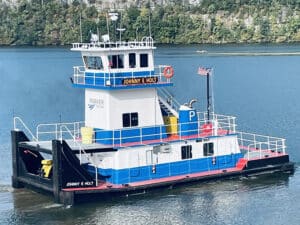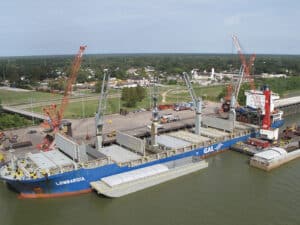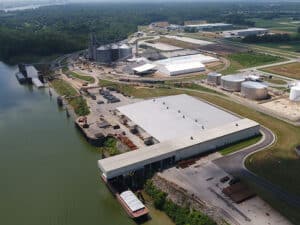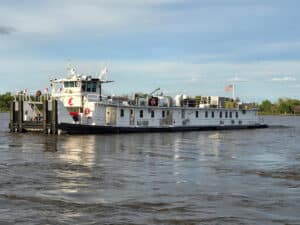
Maritime Partners signs USCG Design Basis Agreement for Hydrogen One
Written by Nick Blenkey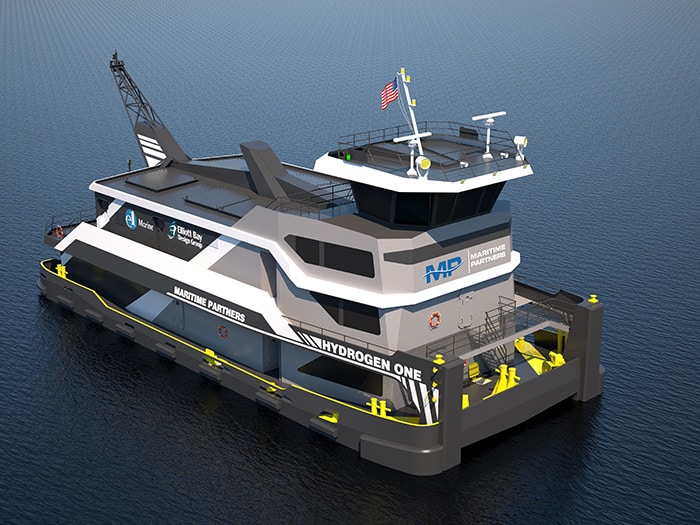
Image: Maritime Partners
Maritime Partners LLC should face fewer regulatory problems than some other innovators in getting its innovative Hydrogen One towboat into actual service. It has received a Design Basis Agreement (“DBA”) from the U.S. Coast Guard for the vessel, which will utilize e1 Marine hydrogen generator technology in its power plant.
M/V Hydrogen One is being designed as a first-of-its-kind vessel using new, cleaner, fuel cell technology that works by converting stored methanol to hydrogen. The produced hydrogen is output, on-demand, to the fuel cell to generate power for the vessel. A successful string test of this technology was completed in Gothenburg, Sweden, in June 2023, proving it to be a viable option as the sole power generation source for vessel propulsion.
“The signing of this agreement opens the pathway for us to deploy our technological capabilities,” said Bick Brooks, co-founder and CEO of Maritime Partners. “With this, Hydrogen One is one step closer to becoming the world’s first vessel to utilize hydrogen generator technology, greatly reducing emissions, increasing efficiency and providing a model for cleaner energy use as the industry continues to seek ways to decarbonize.”
The DBA process was established by the U.S. Coast Guard to set the rules for new and novel technology proposed for installation on marine vessels. Maritime Partners worked with several industry leaders on the Hydrogen One project, including Seattle-based Elliott Bay Design Group, which is designing the towboat; Bourg, La.-based Intracoastal Iron Works which is the selected shipyard; e1 Marine, RIX Industries, Power Cell Group, among others, in order to work through the U.S. Coast Guard requirements.
“Maritime Partners is strongly committed to developing and utilizing sustainable, clean energy solutions, as the entire maritime industry continues to seek alternative fuel options that are cleaner, greener and more efficient. The development of Hydrogen One is part of that commitment,” said Dave Lee, who joined Maritime Partners as VP of technology and innovation in August last year.
“We have been working very diligently on the Design Basis Agreement (DBA) which dates back to prep work that started over a year ago now,” Lee told us. “We officially submitted to the USCG in October of last year and we have been meeting with the USCG Engineering Department once or twice a week to nail down the rule set for this groundbreaking design.
“Captain Dan Cost’s engineering team at the Coast Guard was awesome to work with as we worked through some tough challenges in a very methodical way.”
“We made a decision soon after I joined to focus on engineering and regulatory hurdles that are at the forefront of the project versus the build strategy, steel, equipment, etc.,” Lee continued. “This approach is allowing us to identify design changes while we are still in the design phase versus changing things after we started cutting steel. This approach may sound like it will take longer but the time we spend now will save us time in the build process. Take it from an old shipyard guy, cutting and changing while you are building is expensive and waste serious amounts of time.
“Following the DBA process we now step into the next phase of the project where we will start submitting plans to the USCG Marine Safety Center. This is where the rubber starts hitting the road for any project as the rule set we identified is now applied directly to the vessel and all the subsystems. Again, we have decided to focus on the largest hurdles in front of the team so we will be submitting the most novel system, what we believe will be the most difficult and time consuming first. These are also the items that will have the largest impact on a possible redesign for the vessel, so we feel it is important to have these nailed down before we start submitting the other systems. Once these items are finished, in the eyes of the team, then we have the confidence to start construction and move to the next large step in the project as a boat will come to life. So, it may seem like the project will be a bit quiet for a bit again but once again I can tell you that it is not due to lack of work as the whole team, USCG included, are working very had to make sure this 100% commercial project comes to life in the right way.”

